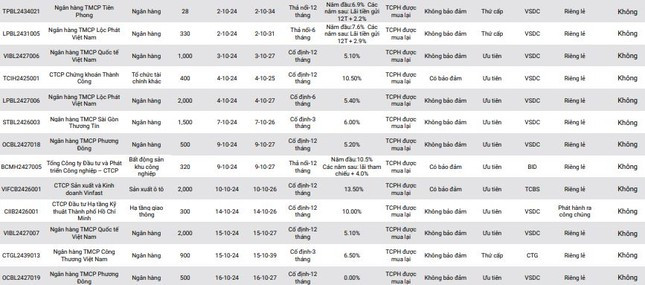Interest rates on newly issued bonds in October for many businesses are up to over 10%/year, in some places up to 12%/year, twice as high as savings interest rates.
According to market report Bonds Latest business of JSC Vietnam Investment Credit Rating (VIS Rating), the amount of new bonds issued in October 2024 only reached 28,100 billion VND. Cumulatively from the beginning of the year until now, the amount of new bonds issued has reached 366,000 billion VND, higher than the total issuance of the whole year 2023.
Accumulated in the first 10 months of the year, the number of issues Bonds The new issuance has reached 366,000 billion VND, higher than the total issuance of the whole year 2023. Many businesses have a interest rate higher than 10%/year.

According to VIS Rating, the bank Commercial bonds accounted for the majority of the new issuance, with VND15,800 billion, of which 20% were Tier 2 bonds - bonds issued by banks to raise capital for other activities. In addition, there are banks that have continuously issued bonds since the beginning of the year.
Banks have always been at the forefront of issuing corporate bonds. The fact that commercial banks are boosting capital mobilization through bonds, despite the higher cost of capital compared to 12-month deposit interest rates, is believed to be aimed at supplementing the medium- and long-term capital structure in the context of gradually recovering loan demand.
According to data from State Bank, credit growth as of October 31 reached 10.08% compared to the end of 2023 and expects credit growth this year to reach 15%.

Regulations on capital safety from the State Bank clearly state that from the end of 2023, banks are required to adjust the ratio of short-term capital used for medium- and long-term loans to 30% instead of 34% as before.
The loan-to-deposit ratio is also required to fall below 85%. Therefore, as a result of this regulation, banks must seek additional capital through the issuance of long-term bonds.
Analysts predict bond issuance activities business will be more active in the fourth quarter, the capital demand of enterprises recovers in the context of the real estate market starting to warm up as well as the demand for production and business expansion is actively following the economic recovery. Accordingly, the banking group will continue to promote bond issuance to supplement capital to meet lending needs.
Source


![[Photo] Closing of the 11th Conference of the 13th Central Committee of the Communist Party of Vietnam](https://vstatic.vietnam.vn/vietnam/resource/IMAGE/2025/4/12/114b57fe6e9b4814a5ddfacf6dfe5b7f)



![[Photo] Overcoming all difficulties, speeding up construction progress of Hoa Binh Hydropower Plant Expansion Project](https://vstatic.vietnam.vn/vietnam/resource/IMAGE/2025/4/12/bff04b551e98484c84d74c8faa3526e0)























































































Comment (0)